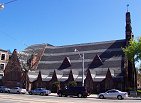Located near Dufferin and College Streets in Toronto’s Parkdale area, the historical plaque outside St. Anne’s reads as follows: “Built in the Byzantine style, St. Anne’s was designed by the noted Toronto architect Ford Howard to serve a large and vigorous parish. It was constructed in 1907-08, replacing an earlier building that stood on the site. In 1923 the interior was richly decorated under the supervision of architect William Rae and artist J.E.H. MacDonald. Members of the Group of Seven and their associates executed the fine paintings in the dome and surrounding the altar. Renowned for its role in the development of Anglican congregations in western Toronto and for its social mission in the Parkdale district, St. Anne’s remains active in community life. In 1968 the parish opened St. Anne’s Tower, a pioneering venture in providing individual apartment accomodation for the elderly.”
St. Stephen-in-the-Fields Anglican Church
St. Stephen’s is located near Bathurst and College Streets at the north end of Kensington Market. The historical plaque on the building reads as follows: “A fine example of Gothic Revival architecture in the style of early English parish churches, St. Stephen-in-th-Fields, named for its original rural setting, represents the work of two of Ontario’s most important 19th-century architects. The church was designed by Thomas Fuller who later gained renown in fashioning Canada’s first parliament buildings and was erected in 1858 by local landowner Robert Denison. Gutted by fire in 1865, it was rebuilt to plans submitted by the prominent church architect Henry Langley. The restored structure which retains most of the design features of the earlier building is distinguished by its polychromatic masonry, solid buttressing and open bellcote. Expanded, then renovated several times, notably in 1985-86, St. Stephen’s remains a landmark within the surrounding community.”
St. Mary’s Roman Catholic Church
St. Mary’s Roman Catholic Church is located on Bathurst Street right where it intersects with Adelaide – in fact this picture was taken from the road, standing in the middle of Adelaide Street. It was built in 1885 and designed by architect Joseph Connolly, also the architect of St. Paul’s Catholic Church on Power Street. The spire was added in 1904, designed by A.W. Holmes. This is an absolutely stunning church with a really unique location. In the late 19th century when the church was erected, it would have served mainly Irish-Catholics in the surrounding working-class neighbourhood. Today the area has a large number of Portugese-born Roman Catholics, who are the principal attendees of the church.
Bloor Street United Church began its life, as many United Churches of today did, as a Presbyterian Church. The United Church came into existence in 1925 as a union of Methodist, Congregational and (some) Presbyterian churches. Located at Bloor and Huron Streets, the church was built in 1889-90 after a group of concerned Presbyterians recognized the need for a church in the rapidly-expanding neighbourhood. At that time streetcars did not run on Sundays in Toronto, making it difficult for local residents to get to the older Presbyterian churches downtown. (this also pre-dated Knox Presbyterian’s move to Spadina and Harbord, which occurred in 1909). More to come on this church at a later date.
Trinity-St. Paul’s United Church
Trinity-St. Paul’s United Church, located on Bloor St. west of Spadina, began its life as Trinity Methodist Church. Noted Toronto architects Langley & Burke designed the building, which was erected between 1887-89. Henry Langley was particularly well-known for his church architecture; his designs included Metropolitan Methodist Church, Jarvis Street Baptist Church, and St. Andrew’s Presbyterian Church (Jarvis and Gerrard). The history of Trinity-St. Paul’s United is rather complex, going back to the United Church union of 1925. At this time Trinity Methodist became Trinity United. In 1980 Trinity United Church was joined by St. Paul’s Avenue Road United, to form Trinity-St. Paul’s United. In turn, St. Paul’s Avenue Road United, located at 121 Avenue Road, was formed in 1930 from former Methodist and Presbyterian congregations – St. Paul’s Methodist and Avenue Road Presbyterian, both of whom became United Churches in 1925. The former St. Paul’s United Church at 121 Avenue Road is now used as a theatre and community centre; Avenue Road United, at Avenue Road and Roxborough, is now home to the Hare Krishna movement.



